- Get link
- X
- Other Apps
- Get link
- X
- Other Apps
We feared the worst with the promise of down to 24 degrees F by Christmas here in St. Augustine, Florida. Thankfully it seems as if we only made it down to 28F in our location (zone 9a), which is something we've had before, but it is also the lowest temperature we have measured by our home in the last 5+ years that we've lived here.
While many of our plants look sad, we're confident most will survive. Yesterday, we uncovered some plants, since it was not going to go below freezing, and today we uncovered the rest and opened up our diy greenhouse which is our attempt to create a semi-permanent solution for plant protection from frost in our growing zone, where we only get freezing temperatures a few times a year.
Make sure to take a look at the tour of our 500 sq ft side garden before the frost at the How to Grow Food in Small Spaces post. This area was a wasted space, because it is so close to the neighbor, but now it is a lush food forest with a great diversity that attracts lots of pollinators and wildlife. In the below video, you can see how this food forest area did in zone 9a after a 28F freeze.
How to Protect Plants from Frost in Florida
If you're wondering how to protect plants from frost in Florida, take a look at our video tour to show you what we did, and read on to get more details.
Florida is such a diverse state with multiple growing zones, and even within each growing zone there are microclimates. If you live close to the beach or close to water, you may not get as low temperatures as other places in your growing zone, but if your garden is exposed to wind, then you will likely suffer greater damage than a similar fenced-in garden with lots of tree canopies etc.
How to Protect Plants from Frost:
- Mulch heavily with woodchips and leaves. Just make sure to clean the mulch off the trunks of the plants after the danger for a freeze has passed.
- Water deeply before the freeze, but try to keep the water off the leaves, and water while early in the day, so any water on the leaves can evaporate.
- Cover with sheets and blankets, and clip them down with clothespins.
- If at all possible, cover to the ground and use rocks and other planters to hold down sheets.
- Do not cover with plastic, as the plants may get burns once the sun gets up.
- If you do cover with plastic, make sure to remove the plastic in the morning to prevent burns.
- Create a mini greenhouse for plant frost protection. Just make sure that it is taller than your plants, so plants will not get burned during the daytime.
- Move plants into your garage.
- Use bulb Christmas lights around your bananas and sensitive trees.
- Select varieties that hold up well against low temperatures.
- Know what plants can handle a mild freeze vs. a hard freeze.
- Young fruit trees are more susceptible to frost damage than more established trees.
- A larger trunk means a tree is better protected. We prune our fruit trees small, to make them easier to manage, to protect and to have room to grow a myriad of different varieties in a small space.
- Plant between structures
- Create microclimates
- Plant cold-sensitive plants in pots, so you can move plants to safety in case of a freeze.
- Plant cold-sensitive plants close to your home.
- Take cuttings of plants and trees and start indoors for spring planting
- Water before and after a freeze.
- Add bottles with water (not completely full) inside your frost protection
- A tree canopy can help protect the plants below it against frost and hard winds.
We are lazy gardeners, and we do not like putting our plants to bed, but if you want to grow tropical fruits in the northern end of Florida, and if you want to push the growing zone and the growing season, then some frost protection for your plants will be necessary.
We are trying to come up with solutions that will make this easier, because as frugal gardeners we grow a lot of fruit trees from seeds and cuttings, and these need to be protected until they reach a certain size.
 |
| Tropical fruit tree frost protection in Northeast Florida |
This year we have created a semi-temporary greenhouse for plant frost protection, so that we can easily cover at night and uncover in the morning to prevent any burns.
We also take cuttings from plants in the ground, and if we can we will put a bucket or sheets over some of our favorites.
Our 9a Garden After the Freeze:
Our recent double-blooming Dwarf Musa Cavendish banana tree was on our biggest worry list, but it seems to have managed well.
It was the only banana that we covered, and we only covered it, because of the new banana hands. Because this banana is still growing bananas, we've got banana-peel water ready for it, and we will be adding more compost to feed it, now that the freeze has gone and warmer temperatures are returning.
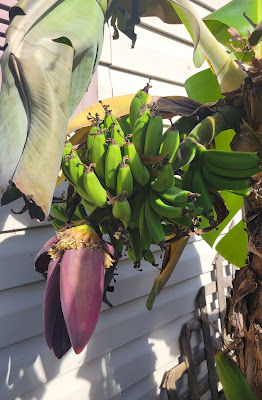 |
| Double-blooming Musa Cavendish banana tree after a freeze in Florida |
All of our bananas have come back from a two-day night freeze before, so we think they will be fine. We've got Dwarf Musa Cavendish Bananas, Dwarf Red Musa Cavendish banana, Raja Puri Bananas, Ice Cream Bananas, Dwarf Namwah Bananas and Grand Nain Bananas plus several bananas of unknown variety, and while they look sad after freezes, they usually recover quickly. We do not cut our bananas to the ground, but ones we're on the other side of Valentine's Day, we'll cut of any dead branches.
We plant most of our bananas close to our home to serve as protection, but we also have bananas at the land, where there are no structures, and they all come back without being covered.
This year we're growing lots of dragonfruit varieties. For the past few years, we've been experimenting with growing dragonfruit from seeds inside and outside, and they are very slow growing.
The happiest one of our dragonfruit cacti from seed is one that is in a small container on top of a rain barrel. The southeast corner outside of our house is a suntrap, and this little dragonfruit sure seems to like it, and it did not get affected by the freezing temps at all.
 |
| Seed-grown dragonfruit after a freeze. |
Dragonfruit grown from cuttings are faster-growing and thereby produce faster, and we've got five new varieties this year.
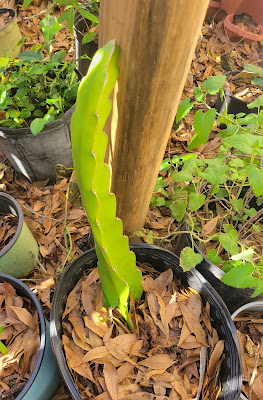 |
| Dragonfruit surving a freeze in Northeast |
Each variety has a pole inside our new greenhouse area, but we also left some dragonfruit from three varieties outside to see how these did, and neither of these suffered any damage.
We moved a few pomegranates of various sizes underneath our halfroof just in case the temperatures did dip below 28 degrees F, but at 28 degrees F/-2 degrees C, no damage was sustained to any of the pomegranates we left unprotected.
Every year we experiment with our seed-grown starfruit trees.
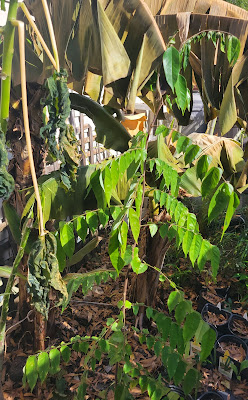 |
| Unprotected Starfruit (Carambola) grown from seed after a freeze in Northeast Florida |
Last year we protected one starfruit (Carambola) and left one out, and the one left unprotected did just fine.
The papayas look just as sad as the bananas, but they do not look as if they sustained fatal damage, so we think they will recover. We take a watch and see approach, but you can read about how to save your papayas after a freeze here.
We had one very exposed papaya (a volunteer) that did amazing and barely flinched at the freeze. You can see the bougainvillea in the back got hit by the cold, but this too will come back.
 |
| A volunteer papaya after the freeze in St. Augustine, Florida. |
We have many seed-grown purple passionfruit vines around our home. One 2-year-old passionfruit vine just produced passionfruits for the first time this fall. It is a bit late in the season, but it suffered severe frost damage earlier in the year, so we cut it back, and it had quite a comeback.
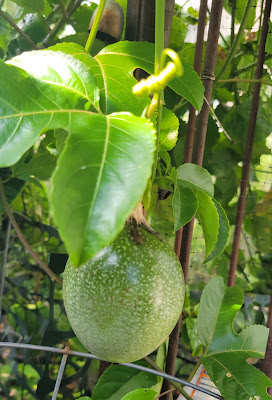 |
| Purple passionfruit from seed after a freeze in Florida |
This passionfruit vine with fruit on was mostly protected inside our diy greenhouse, and any passionfruit vine not protected suffered freeze damage. From past experiences, we know that they will come back.
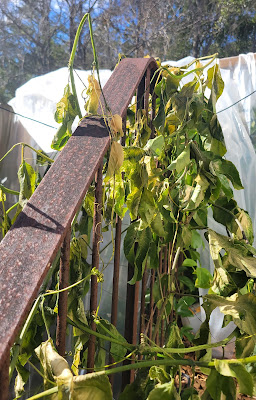 |
| Purple passionfruit after a freeze. |
We will cut back the frost-damaged passionfruit vines, when all chances of frost have passed, and they will come back even stronger growing as much as 6 yards, if grown in full sun.
 |
| Sweet potato vine frost damage |
Just like the passionfruit vines, the sweet potato vines suffered greatly in the freeze. We had cut a bunch and fed to the chicken before the freeze, and while some will die back completely, some will recover like previous years. We enjoy eating sweet potato leaves all year round, which is why we brought some sweet potato cuttings inside, so we can continue to harvest sweet potato leaves throughout the winter months.
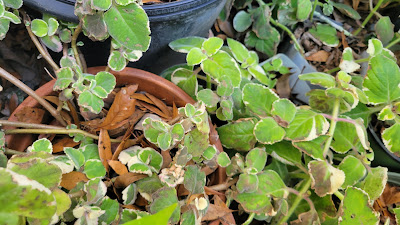 |
| Cuban oregano is cold-sensitive, but will regrow in the spring. |
Cuban oregano is another cold-sensitive plant in our garden. It even suffered damage inside our frost protection area, but most of the Cuban Oregano will come back in the spring.
 |
| Avocado seedlings, pomegranate seedlings and peppers after the freeze. |
We have loads of avocado trees in various sizes and growth stages, and while we did put a couple of young avocado seedlings inside the greenhouse area in case the temperatures went below 28F, we did confirm that it is not needed at those temperatures. None of our avocado seedlings suffered any frost damage, and we prefer to leave them outside, so that they can harden off and become more resilient avocado trees.
Tropical spinaches such as Sissoo Spinach, Hoan Ngoc, Longevity Spinach, Okinawa Spinach, Malabar Spinach and more grow in many places throughout our garden. Most were left to fend for themselves, but we took cuttings, and made sure to have at least one rooted cutting of each in our frost plant-protection area, and we hope some will come back in the spring.
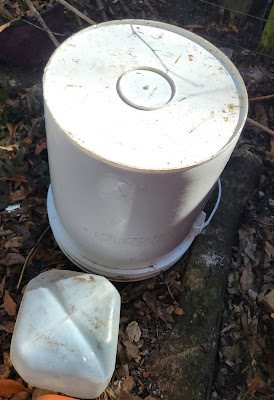 |
| A bucket and a cut milk carton protecting Longevity Spinach from Frost in Florida. |
A bucket and a cut milk carton protected some of our Longevity Spinach from the freeze, but one leaf had been left outside the carton, and the frost damage to this leaf is clear.
 |
| Longevity Spinach after having been protected from frost in Florida. |
How to Save Your Plants After a Freeze:
- Water well before and after a freeze.
- Make sure to uncover any plastic coverings during the daytime to prevent burns on your plants.
- Leave pruning until the spring in most cases. We usually wait with pruning until after Valentine's Day.
- In the case of plants such as papayas, it might be better to cut the papaya early, if part of of the papaya trunk is damaged beyond repair in an early freeze. This way, you can protect the cut part in case of another freeze.
- We make another exception to the no-prune philosophy, when it comes to plants with rhizomes such as cannas, ginger, turmeric and shell ginger.
- Make sure to clean extra mulch off the trunks of the plants and trees after the danger of frost has passed.
Whenever we have more than one of a plant, we always try to experiment to see, which plants do well in a freeze, and which ones need to be covered in zone 9a/9b before a freeze.
Some plants such as Cuban oregano, Insulina, Passionfruit, Moringa and Katuk may die back but will likely regrow in the spring. If you want to start the season of strong, you can protect these.
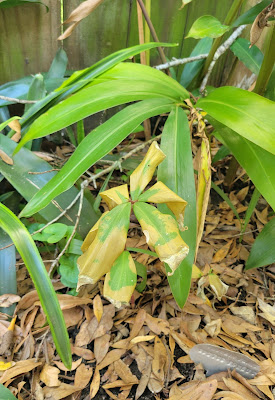 |
| Insulin (Insulina) plant with frost damage - no protection. It will come back in the spring. |
What to Cover Before a Mild Freeze in zone 9A/9B:
- Young tropical fruit trees such as Black Sapote, White Sapote, Blackberry Jam Tree, Guavas, Cherry of the Rio Grande, Barbados Cherry, Suriname Cherry, Jamaican Cherry, and Jaboticaba.
- Tropical spinaches such as Sissoo, Okinawa Spinach and Longevity Spinach.
- Cuban oregano
- Passionfruit vines with fruit on them
- Papayas if small and you can cover, but they will survive mild night freezes for a day or two.
- Sweet potato (or simply take cuttings or leave sweet potatoes in ground and many will come back in the spring)
- Peppers (Some pepper plant will survive a mild freeze, and some will not)
- Hoan Ngoc - we left some out and protected some. The unprotected Hoan Ngoc looks sad, but it survived.
- Tomatoes
- Insulina (It will regrow in spring, but if you want to get a headstart on the season, protect it from frost.
What not to Cover Before a Mild Freeze in Growing Zone 9A/9B:
- Avocado seedlings
- Dragonfruit
- Starfruit/Carambola
- Bananas of certain kinds - grand nain, musa cavendish, raja puri, dwarf namwah and ice cream bananas have survived freezes with temps down to 28F in our gardens.
- Olive trees
- Native trees such as Elderberry, beautyberry, American Persimmons and Paw Paw.
- Loquat/Japanese Plum
- Grapevines
- Mulberry
- Blackberries (These love the cold)
- Raspberries (These love the cold)
- Blueberries (These love the cold)
- Apple trees (These love the cold)
- Plum trees (These love the cold)
- Peach trees (These love the cold)
- Lemongrass
- Figs
- Shell Ginger (While they may suffer some damage)
- Passionfruit vines without fruit (They may suffer damage, but will recover)
- Citrus
- Date palms
- Chaya (Chaya die back in a freeze, but will likely regrow in the spring)
- Moringa (Moringa will die back in a freeze, but will likely regrow in the spring)
- Older Guavas and other fruit trees with a substantial trunk size.
- Prayer plants (Will die back but come back in the spring)
- Gardenia
- Insulina (Will die back but regrow in spring)
- Peace Lily (Will get damage but regrow in spring)
- Cranberry Hibiscus (Will die back but regrow in spring - save seeds if possible)
 |
| Our Tangerine tree did great, as did all of our other citrus trees after the 28F freeze in Northeast Florida. |
Now, if temperatures below 28F/-2C are forecasted, we recommend protecting bananas, papayas and passionfruit vines if possible, but as always we believe in planting so much that it is not a disaster, if a plant is hit by frost or insects. We do not use pesticides, and in return we've got a garden full of beneficial insects and pollinators.
Of course, you can just stay away from any frost-sensitive plants, and you won't have to worry about how to protect your plants from a freeze in Florida. Or you can treat all of your plants like annuals, and start new plants in the spring.
However, with a little planning the growing season in Florida can be extended, and if you nurse smaller fruit trees to maturity, you can soon have a diverse food forest or fruit trees that can sustain themselves when the temperatures do dip a few times a year.
You have seen the damage that freezing temperatures can have on a food forest in zone 9, but take a look at just how much food we're growing in this 500 sq ft space at the side of our house in our Growing Food in Small Spaces post.
Help support us by connecting with Dancing Treetops on Facebook, Instagram, You Tube and Pinterest. We want to see your garden pictures.
9a Food Forest
9a Fruit Trees
Grow Your Own Food
Growing Bananas
growing dragon fruit
Growing Papaya
Growing Passionfruit
How to Grow Food In a Small Garden
Plant Protection from Frost
- Get link
- X
- Other Apps
Popular Posts
Troy-Bilt Wood Chipper - Super Tomahawk = Our No. 1 Tool For Better Composting
We could not have gotten as far with our sustainable land clearing and composting, if it had not been for our power horse, our Troy-Bilt Super Tomahawk wood chipper with its 8 HP Briggs & Stratton motor. We purchased this 31+ year-old wood chipper off Craigslist for $200 about a year and a half ago, and it is still going strong. Troy-Bilt Super Tomahawk Wood Chipper
Zone 9A/9B Gardening Calendar - North East Florida Planting Schedule
Gardening in Florida is a very different experience than gardening in the rest of the country, and growing fruits and vegetables in North East Florida is a very different experience than gardening down south. It has taken us about five years to adjust to the zone 9 planting schedule, and while there are many zone 9 garden guides out there, we felt that there was a need for a simple, user friendly zone 9A/9B planting calendar.
How To Remove Palmetto Palms
If you have ever tried to remove a palmetto palm by cutting it down, you will likely have realized that removing palmettos is tricky. So, when we got ourselves a piece of land with about half an acre of these wonderful palmetto palms, also known as saw palmettos or shrub palmettos, we knew that we had a challenge on our hand.
Where To Find Free Nursery Pots and Planters
Every gardener needs something for their plants to grow in. Whether it is directly into the soil in your garden, into a garden bed, nursery pots, ceramic pots, terracotta pots, or if you get more creative, you need something for your plants to grow in. That's why we're always looking for free nursery pots and cheap planters.
How to Transplant a Banana Tree
Wondering how to transplant a banana tree? I know, it's not a tree, so wondering how to move a banana plant? Bananas are pretty easy to move, and they're pretty hardy too. The best time to transplant a banana plant is in the rain season, but I've planted and re-planted banana plants all year round, just remember to water well if it doesn't rain. Last year I planted a small ice cream banana pup in front of our home, but I was negligent in my research and didn't realize just how big it would get. I prefer moving banana trees in the rain season, but the leaves were getting too close to our power line, so it had to be moved. The roots of banana trees aren't very deep, and they will quickly re-establish, if you give them some love and water. The root ball of a 1 year old Grand Nain banana We've been preparing an area at The Land for banana babies, since we now have six different banana varieties at the house and these are beginning to give us pups. Today was th...
How to Grow Mulberry from Cuttings
Our favorite mulberry bush is in danger of eradication, so for the past year or so we have been growing mulberries from cuttings. Our children love eating fruit straight from the trees and bushes, and while we lose wild areas every day to construction and development in our community, we still have a few areas left untouched for now. Some mulberry trees are simply too tall for great mulberry picking, but this one mulberry bush is low and spread thick like a bush. Mulberries look similar to blackberries, but they are sweeter and juicier. They do not hold up well, which is why you will not find them in the stores, but we freeze any leftover mulberries to use in our weekly smoothies. Wild blackberries and wild mulberries We've taken cuttings three times from the mulberry bush. We waited until after fruiting last spring to take the first cutting, and the second time was about four months after fruiting. The third set of cuttings we took was in late winter, just as the mulberry bush had...
Save Your Papaya Trees After Cold Damage
Papayas are susceptible to high winds and freezes, but do not let that prevent you from growing papayas in zone 9a or 9b. In our experience, papayas are pretty cold hardy, but they do not like temperatures below freezing, especially not a sustained time with freezing temperatures. Temperatures below 40 degrees F/4 degrees C will make the papayas begin to look sad, but it is not until the temperatures hit freezing, that the papaya trees will sustain damage enough to kill the papayas. Last winter we had two quick freezes here in St. Augustine (growing zone 9a), and while our tallest papayas looked sad after the first freezing night, it was not until the second freeze that they were defeated. How to Save Papayas After a Freeze: After a freeze wait and see for a week or two to determine where you need to cut your papayas. If another freeze is imminent before your wait or see period is over, make the cut low, cover and protect. Look for new growth or a firmer trunk. Cut the papaya trun...
How To Make Permanent Plant Tags out of Recycled Plastic, Aluminum & Copper
We have lots of citrus trees in the garden, but until they produce fruits, they will be just that - citrus trees - because I have no clue what type they are, since most of my plant tags never held up. I've tried many different plant tags from chalk signs to plastic and the infamous popsicle stick. All failed the test of time, but when I started selling plants, I had to come up with some way to identify the plants and trees to make it easier for the customers. I wanted something that would last at least 6 months, could stand up against the weather, and I began looking for plastic plant tags. I had a hard time finding affordable, recycled plastic plant tags, so I decided to create my own permanent plant tags . (< see video) We've also begun a complete revamp of our front garden, which means more plants, and we've got lots of plants and trees growing for our future garden at The Land. For these plants, I wanted permanent plant labels that could contain both the common name ...
Finding Free Plants on Craigslist
If you are looking to add new plants to your garden, make sure to keep an eye out for free plants in the free section on Craigslist. We have picked up free plants a few times, when someone is clearing out their garden, and in return we make sure to post items as well. This morning I spotted a post for a free estate sale on Craigslist, and it included potted plants. It was in a fancy neighborhood by the beach, where an old house was being torn down to build a new huge one. We picked up several knick knacks such as plates, vases,paintings, lamps, a coat rack, a book shelf and more, and we also brought home as many big pots and plants as our mini van could fit. Free pots and plants These pots were the big ceramic kind that are not in our teacher's budget, and there were lots of different plants too. The plants need to be re-potted and re-nourished, but we've added some new plant species to our garden, which we will make sure to create more plants from trough seeds and ...
How To Grow Papaya From Seeds
Papaya is one of the easiest fruit trees to grow, if you provide them with the right conditions. Here in North East Florida we are in growing zone 9, and while papaya prefer warmer winters than we have here, we have still had great success. Eat a papaya, grow a papaya. We got the idea to grow papaya from seeds, when one of our children began suffering from constipation. The pediatrician suggested that we added papaya to the diet, because papaya is a diuretic. However, papaya can be expensive often costing $5 for a single fruit, and sometimes papaya can be hard to find at the store. For a frugal family of seven, this means papaya is a luxury, so we now make sure to have papaya trees of all sizes planted around the house. Each papaya fruit has a myriad of seeds, and they are so easy to start. Papaya does not like to be transplanted, although we have been able to do so with varying degrees of success, so plant the papaya directly in the soil outside. If you are in zone 10+, you ...













Comments
Post a Comment